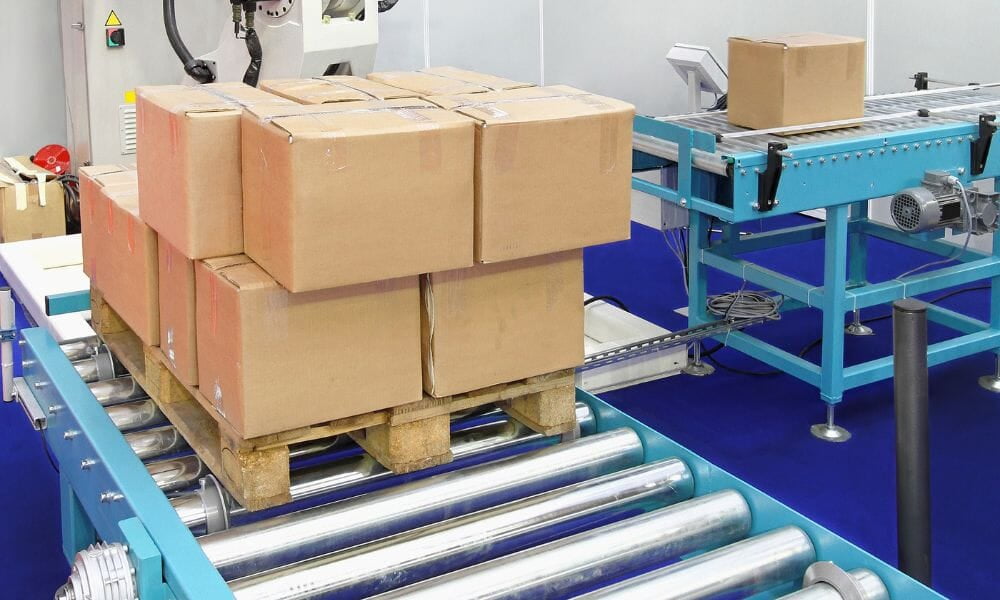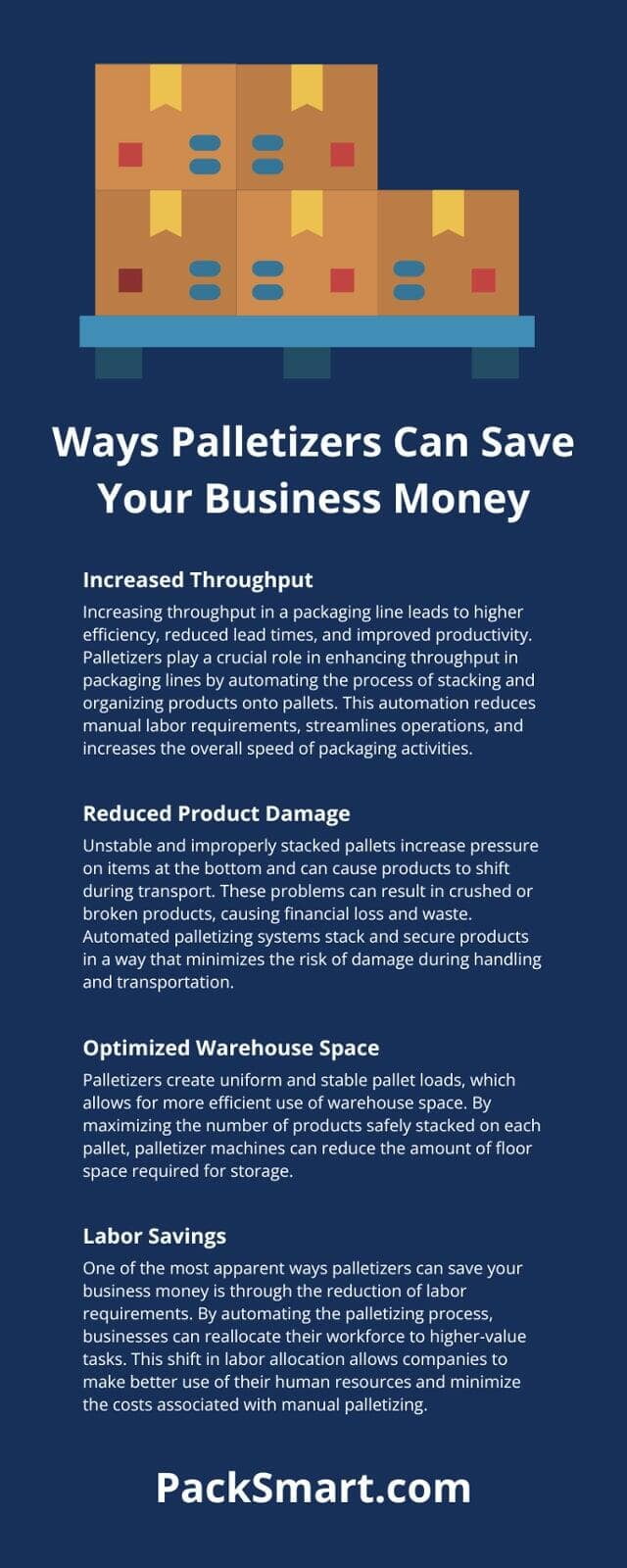
The quality of palletized loads affects your business’s packaging, shipping, and storage efficiency. Palletization is also key for ensuring that products reach their destinations in optimal condition. Automated palletizers methodically place goods onto pallets in a predefined arrangement, keeping items organized, aligned, and secure. Explore seven ways palletizers can save your business money on packaging, storage, and transportation.
Increased Throughput
Increasing throughput in a packaging line leads to higher efficiency, reduced lead times, and improved productivity. Palletizers play a crucial role in enhancing throughput in packaging lines by automating the process of stacking and organizing products onto pallets. This automation reduces manual labor requirements, streamlines operations, and increases the overall speed of packaging activities.
Additionally, palletizers improve consistency and accuracy in palletized loads. Through precise stacking patterns and configurations, palletizers ensure that each palletized load is uniform and compliant with specific requirements. Consistent, accurate loads maximize production output and minimize the need for rework.
Reduced Product Damage
Unstable and improperly stacked pallets increase pressure on items at the bottom and can cause products to shift during transport. These problems can result in crushed or broken products, causing financial loss and waste. Automated palletizing systems stack and secure products in a way that minimizes the risk of damage during handling and transportation. By ensuring proper stacking and securement, palletizers help protect products from the wear and tear of the supply chain process.
Reducing product damage has a direct impact on your bottom line. Fewer damaged goods mean fewer losses and less need for replacements or refunds. Additionally, delivering products in pristine condition to customers helps improve satisfaction and maintain brand reputation. By minimizing product damage, palletizers contribute to cost savings and customer loyalty.
Optimized Warehouse Space
Palletizers create uniform and stable pallet loads, which allows for more efficient use of warehouse space. By maximizing the number of products safely stacked on each pallet, palletizer machines can reduce the amount of floor space required for storage.
Furthermore, the consistent stacking patterns created by palletizers make it easier to organize and manage your inventory. Well-organized warehouse space not only saves time and effort in locating and retrieving products but also facilitates more accurate inventory tracking. By optimizing your warehouse space with the help of palletizers, you can reduce costs associated with storage and improve overall operational efficiency.
Labor Savings
One of the most apparent ways palletizers can save your business money is through the reduction of labor requirements. By automating the palletizing process, businesses can reallocate their workforce to higher-value tasks. This shift in labor allocation allows companies to make better use of their human resources and minimize the costs associated with manual palletizing.
In addition to direct labor savings, palletizers contribute to a safer work environment. Manually stacking loads can lead to musculoskeletal injuries and strains due to repetitive lifting and bending motions. By automating this process, businesses can reduce the likelihood of workplace accidents and the associated costs of worker compensation and lost productivity.
Reduced Load Rejection
Thanks to their consistent stacking patterns and optimal load distribution, palletizing machines can reduce the number of rejected or reworked loads. Load rejection in palletizing refers to when someone in the supply chain deems a palletized load unsuitable for shipment or storage due to various issues, such as instability, damage, or non-compliance with safety standards.
Rejected or reworked palletized loads increase costs associated with additional labor, materials, and time needed to correct errors. These inefficiencies not only lead to financial losses but also disrupt supply chain operations, potentially causing delivery delays and affecting customer satisfaction.
The following palletizing errors can cause load rejection:
- Unstable loads: Poor palletizing techniques can result in unstable loads prone to shifting and collapsing during handling or transit.
- Product damage: Incorrect stacking methods may lead to crushed, dented, or broken products within the load.
- Safety risks: Improperly palletized loads pose safety risks to warehouse personnel and transport workers due to falling or shifting items.
- Space inefficiency: Inefficient palletizing techniques can waste valuable warehouse space, leading to higher storage costs and reduced capacity.
- Transportation issues: Load rejection can occur if palletized loads are not properly secured, leading to damage during transportation.
Enhanced Supply Chain Efficiency
Properly palletized loads facilitate smoother transportation and distribution processes, leading to enhanced supply chain efficiency. Load handlers can safely move stable and well-organized loads using forklifts and other material handling equipment, reducing loading and unloading times. This increased efficiency translates to lower shipping costs and faster delivery times.
Optimizing Transportation
Trucking plays a crucial role in the supply chain, influencing inventory management, distribution strategies, and overall customer satisfaction. Businesses rely on cargo trucks for flexibility in shipping schedules, cost-effective transportation solutions, and the ability to scale operations based on demand fluctuations.
Palletizers enhance trucking efficiency by allowing businesses to stack products securely and maximize truck space utilization. By palletizing loads effectively, businesses can transport more goods per shipment. This optimization reduces the number of trips required, cuts down on fuel costs, and ultimately improves the overall transportation efficiency and cost-effectiveness of their operations.
Scalability and Flexibility
As businesses grow and evolve, their palletizing needs may change. Fortunately, palletizers adapt to various product types, sizes, and packaging configurations. Their flexibility accommodates changes without requiring significant investments in new equipment. This scalability allows businesses to easily expand their operations and handle increased production volumes without incurring substantial costs.
Moreover, equipment operators can program palletizers to handle different palletizing patterns and load configurations, enabling businesses to quickly adjust to changing customer requirements or market demands. This flexibility is particularly valuable in industries with seasonal fluctuations or rapidly evolving product lines. By investing in versatile palletizing solutions, businesses can remain agile and responsive to market dynamics.
Automated palletizers control costs and make operations more efficient in numerous ways, from reducing product damage and labor costs to optimizing warehouse space and enhancing supply chain agility. The scalability and flexibility provided by these machines support business growth and adaptation without necessitating high capital investments. By ensuring consistent and precise palletizing, businesses can minimize load rejection rates, thereby safeguarding brand reputation and customer satisfaction. Ultimately, investing in palletizing technology yields both immediate and long-term benefits in streamlining operations and bolstering net income.

